人教版小学六年级总复习英语语法知识最全整理+语法专项训练题
小学人教版英语语法专项训练答案
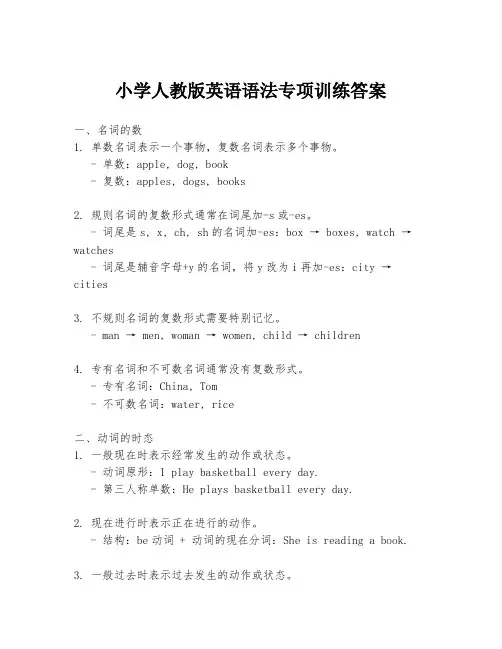
小学人教版英语语法专项训练答案一、名词的数1. 单数名词表示一个事物,复数名词表示多个事物。
- 单数:apple, dog, book- 复数:apples, dogs, books2. 规则名词的复数形式通常在词尾加-s或-es。
- 词尾是s, x, ch, sh的名词加-es:box → boxes, watch → watches- 词尾是辅音字母+y的名词,将y改为i再加-es:city → cities3. 不规则名词的复数形式需要特别记忆。
- man → men, woman → women, child → children4. 专有名词和不可数名词通常没有复数形式。
- 专有名词:China, Tom- 不可数名词:water, rice二、动词的时态1. 一般现在时表示经常发生的动作或状态。
- 动词原形:I play basketball every day.- 第三人称单数:He plays basketball every day.2. 现在进行时表示正在进行的动作。
- 结构:be动词 + 动词的现在分词:She is reading a book.3. 一般过去时表示过去发生的动作或状态。
- 规则动词:加-ed:I watched a movie yesterday.- 不规则动词:需要特别记忆:He went to the park yesterday.4. 一般将来时表示将来发生的动作或状态。
- 结构:will + 动词原形:I will go to the library tomorrow.三、形容词和副词的比较级和最高级1. 形容词和副词的比较级用于比较两者。
- 规则:词尾加-er:big → bigger- 不规则:good → better2. 形容词和副词的最高级用于比较三者或三者以上。
- 规则:词尾加-est:big → biggest- 不规则:good → best3. 比较级和最高级的前面可以加上much, a little, a lot, a bit, even, far等词来加强语气。
六年级英语语法总复习练习题
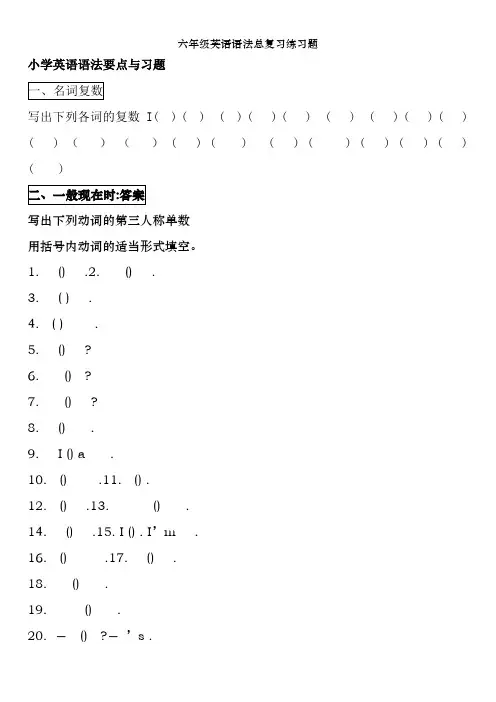
小学英语语法要点与习题写出下列各词的复数 I( ) ( ) ( ) ( ) ( ) ( ) ( ) ( ) ( ) ( ) ()() ( ) ( ) ( ) ( ) ( ) ( ) ( ) ( )写出下列动词的第三人称单数用括号内动词的适当形式填空。
1. () .2. () .3. ( ) .4. ( ) .5. () ?6. () ?7. () ?8. () .9. I () a .10. () .11. () .12. () .13. () .14. () .15. I () . I’m .16. () .17. () .18. () .19. () .20. -() ?-’s .按照要求改写句子1. .(改为否定句)2. ?(作肯定回答)3.? (作否定回答)4.? (改为一般疑问句)5. .(改为否定句)6. .(改为否定句)7.I . (对划线部分提问)8. .(对划线部分提问)9. a .(改为一般疑问句,作否定回答)10. .(改为否定句)改错(划出错误的地方,将正确的写在横线上)1. ?2. ?3. .4. .5. ’t .写出下列动词的现在分词:用所给的动词的正确形式填空:1 ( )a .2. ( ) .3. ( ) .4. ( ) ?5. . ( ) .6 ( ) .7! ( ) .8 ? ( ) .9. ’s 5 o’ . ()10( )? .句型转换:1. .(分别改成一般疑问句和否定句)2. . ( 改一般疑问句并作肯定和否定回答) 3.I’m .(对划线部分进行提问)4. . (对划线部分进行提问)填空。
1. 我打算明天和朋友去野炊。
a .I a .2. 下个星期一你打算去干嘛? 我想去打篮球。
?3.你妈妈这个周末去购物吗?是,她要去买一些水果。
?, . .4.你们打算什么时候见面。
?改句子。
5. .(改否定).6’ .(改否定)I .7. I’m 6:30 .(改一般疑问句)6:30 ?8. 10:30.(改一般疑问句)10:30.9. .(划线部分提问)?10. a .(同上)a .用所给词的适当形式填空。
小学英语(人教版PEP版)语法要点详解及练习题-六年级-小升初必备大全[1]
![小学英语(人教版PEP版)语法要点详解及练习题-六年级-小升初必备大全[1]](https://uimg.taocdn.com/4849ad2c453610661ed9f46b.webp)
小学英语(人教版PEP版)语法要点及习题1名词复数规则1.一般情况下,直接加-s,如:book-books, bag-bags, cat-cats, bed-beds2.以s. x. sh. ch结尾,加-es,如:bus-buses, box-boxes, brush-brushes, watch-watches 3.以“辅音字母+y”结尾,变y为i, 再加-es,如:family-families, strawberry-strawberries 4.以“f或fe”结尾,变f或fe为v, 再加-es,(但有一个特例:roof→roofs)。
如:knife-knives leaf-leaves wife-wives thief-thieves wolf-wolves5.以“o”结尾的单词,如果有生命,加-es;如果没有生命,加-s。
如:①有生命:potato-potatoes tomato-tomatoes mango-mangoeshero-heroes Negro- Negroes②没生命:radio-radios piano-pianos photo-photos zoo-zoos6.不规则名词的复数变化:(一)完全不规则:man-menwoman-womenpoliceman-policemenpolicewoman-policewomenmouse-micechild-childrenfoot-feettooth-teeth(二)单数复数词形相同:fish-fish sheep-sheep deer-deerpeople-peopleChinese-ChineseJapanese-Japanese小练习:写出下列各词的复数I _________him _________this ___________her ______watch _______child _______photo ________diary ______day________ foot________ book_______ dress ________tooth_______ sheep ______box_______ strawberry _____thief _______yo-yo ______ peach______ sandwich ______man______ woman_______ paper_______ juice___________water________ milk________ rice__________ tea__________小学英语(PEP版)语法总结及习题2一般现在时一般现在时基本用法介绍【No. 1】一般现在时的功能1.表示事物或人物的特征、状态。
人教版小学六年级英语下册复习语法知识及配套习题精选文档
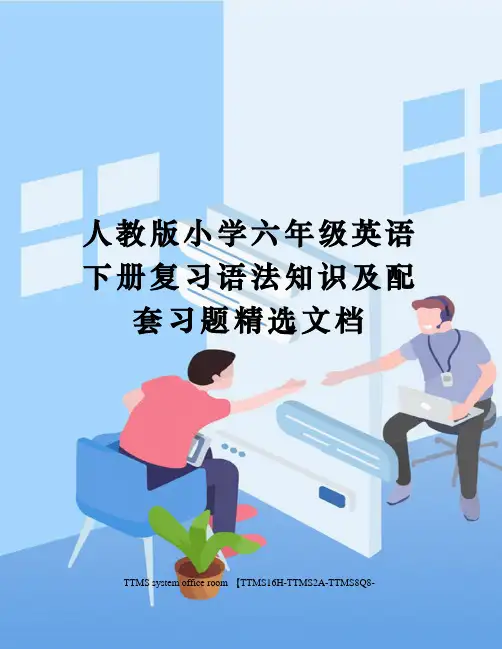
人教版小学六年级英语下册复习语法知识及配套习题精选文档TTMS system office room 【TTMS16H-TTMS2A-TTMS8Q8-小学英语语法及习题一、名词复数规则1.一般情况下,直接加-s,如:book-books, bag-bags, cat-cats, bed-beds2.以s. x. sh. ch结尾,加-es,如:bus-buses, box-boxes, brush-brushes, watch-watches3.以“辅音字母+y”结尾,变y为i, 再加-es,如:family-families, strawberry-strawberries 4.以“f或fe”结尾,变f或fe为v, 再加-es,如:knife-knives5.不规则名词复数:man-men, woman-women, policeman-policemen, policewoman-policewomen, mouse-micechild-childrenfoot-feet,.tooth-teethfish-fish, people-people, Chinese-Chinese, Japanese-Japanese写出下列各词的复数I _________him _________this ___________her ______watch _______child _______photo ________diary ______day________ foot________ book_______ dress________tooth_______ sheep ______box_______ strawberry _____thief _______yo-yo ______ peach______ sandwich ______man______ woman_______ paper_______juice___________water________ milk________ rice__________tea__________二、一般现在时一般现在时基本用法介绍【No. 1】一般现在时的功能1.表示事物或人物的特征、状态。
小学英语(人教版PEP版)语法要点详解及练习题六年级小升初必备大全(17页)
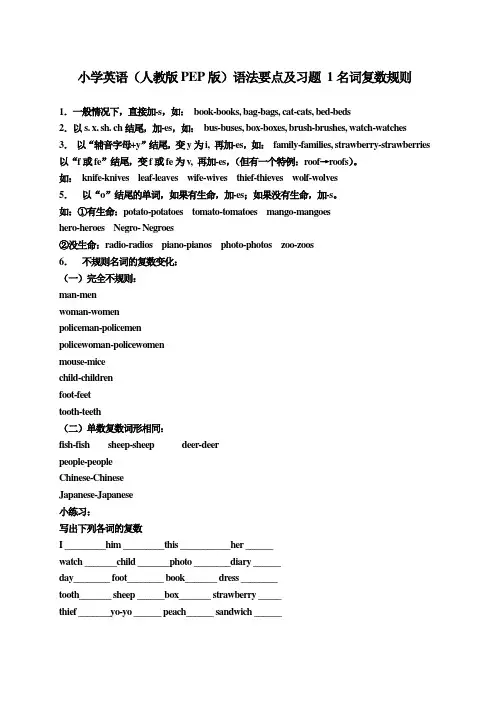
小学英语(人教版PEP版)语法要点及习题1名词复数规则1.一般情况下,直接加-s,如:book-books, bag-bags, cat-cats, bed-beds2.以s. x. sh. ch结尾,加-es,如:bus-buses, box-boxes, brush-brushes, watch-watches 3.以“辅音字母+y”结尾,变y为i, 再加-es,如:family-families, strawberry-strawberries 以“f或fe”结尾,变f或fe为v, 再加-es,(但有一个特例:roof→roofs)。
如:knife-knives leaf-leaves wife-wives thief-thieves wolf-wolves5.以“o”结尾的单词,如果有生命,加-es;如果没有生命,加-s。
如:①有生命:potato-potatoes tomato-tomatoes mango-mangoeshero-heroes Negro- Negroes②没生命:radio-radios piano-pianos photo-photos zoo-zoos6.不规则名词的复数变化:(一)完全不规则:man-menwoman-womenpoliceman-policemenpolicewoman-policewomenmouse-micechild-childrenfoot-feettooth-teeth(二)单数复数词形相同:fish-fish sheep-sheep deer-deerpeople-peopleChinese-ChineseJapanese-Japanese小练习:写出下列各词的复数I _________him _________this ___________her ______watch _______child _______photo ________diary ______day________ foot________ book_______ dress ________tooth_______ sheep ______box_______ strawberry _____thief _______yo-yo ______ peach______ sandwich ______man______ woman_______ paper_______ juice___________water________ milk________ rice__________ tea__________小学英语(PEP版)语法总结及习题2一般现在时一般现在时基本用法介绍【No. 1】一般现在时的功能1.表示事物或人物的特征、状态。
小学六年级英语语法专项训练-人教版
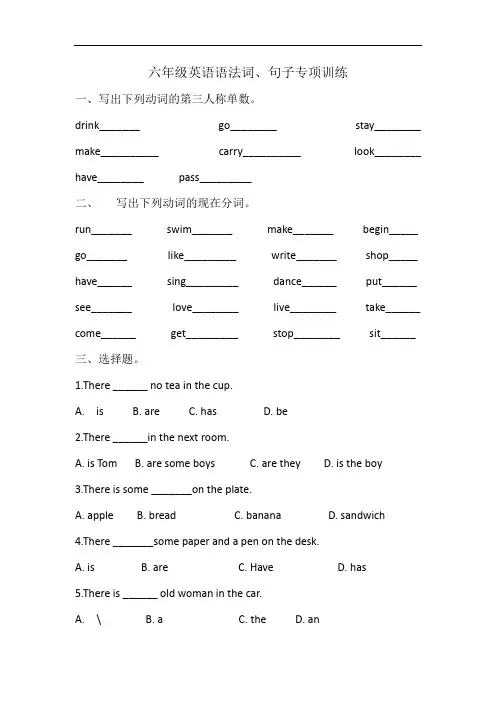
六年级英语语法词、句子专项训练一、写出下列动词的第三人称单数。
drink_______ go________ stay________ make__________ carry__________ look________ have________ pass_________二、写出下列动词的现在分词。
run_______ swim_______ make_______ begin_____ go_______ like_________ write_______ shop_____ have______ sing_________ dance______ put______ see_______ love________ live________ take______ come______ get_________ stop________ sit______三、选择题。
1.There ______ no tea in the cup.A. isB. areC. hasD. be2.There ______in the next room.A. is TomB. are some boysC. are theyD. is the boy3.There is some _______on the plate.A. appleB. breadC. bananaD. sandwich4.There _______some paper and a pen on the desk.A. isB. areC. HaveD. has5.There is ______ old woman in the car.A. \B. aC. theD. an四、用所给动词的正确形式填空。
1.The boy __________(draw) a picture now.2.Listen , some girls _________(sing)in the classroom.3.My mother_________(cook) some nice food now.4.What _____you______(do) now?5.Look. They _______(have) an English lesson.6.It____(be) Ben’s birthday last Friday.7.We all______(have)a good time last night.8.He _______(jump) high on last Sports Day.9.Helen_______(milk)a caw on Friday.10.She likes _____ newspapers, but she _______ a book yesterday.(read)11.Today is a sunny day .We ______(have)a picnic this afternoon.12.Tom often ________(go)to school on foot.But today is r ain. He _______ (go) to school by bike.13.LeiFeng often ________(help) others and he was helpful.14.Wha t _______his father usually _______(do) in the evening?15.Do you believe what he ______(say) just now?五、翻译句子。
人教版PEP小学英语六年级语法训练
小学英语六年级语法训练语法及练习1 be动词Be 动词的用法:(1) Am--was Is --was Are--were 口诀:我用am, 你用are, is用在他她它,复数全用are。
(2) 肯定和否定句I am (not) from London. He is(not) a teacher. She is(not) in the dining room. My hair is(not)long. Her eyes are(not) small.(3) 一般疑问句Am I a Chinese? Yes, you are. No, you aren’t. Are they American? Yes, they are. No, they aren’t. Is the cat fat? Yes, it is. No, it isn’t.用恰当的be动词填空。
1. I ______ a boy. ______ you a boy? No, I _____ not.2. The girl______ Jack's sister.3. The dog _______ tall and fat.4. The man with big eyes _______ a teacher.5. ______ your brother in the classroom?6. Where _____ your mother? She ______ at home.7. How _______ your father?8. Mike and Liu Tao ______ at school.9. Whose dress ______ this?10. Whose socks ______ they?11. That ______ my red skirt.12. Who ______ I?13.The jeans ______ on the desk.14. Here ______ a scarf for you.15. Here ______ some sweaters for you.16. The black gloves ______ for Su Yang.17. This pair of gloves ______ for Yang Ling.18. The two cups of milk _____ for me.19. Some tea ______ in the glass.20. Gao shan's shirt _______ over there.21. My sister's name ______Nancy.22. This ______ not Wang Fang's pencil.23. ______ David and Helen from England?24. There ______ a girl in the room.25. There ______ some apples on the tree.26. _______ there any kites in the classroom?27. _______ there any apple juice in the bottle?28. There _______ some bread on the plate.29. There _______ a boy, two girls, three men and ten women in the park.30. You, he and I ______ from China.语法及练习2 人称代词和物主代词人称代词和物主代词1.人称代词主格和宾格的区别:主格通常位于句中第一个动词之前(有时候位于than 之后),宾格一般位于动词或介词之后。
人教版小学六年级英语语法复习大全汇总
人教版小学六年级英语语法复习大全汇总小学六年级英语语法复习大全汇总一、名词名词可以分为专有名词(Proper Nouns)和普通名词 (mon Nouns),专有名词是某个(些)人,地方,机构等专有的名称,如Beijing,China等。
普通名词是一类人或东西或是一个抽象概念的名词,如:book,sadness等。
普通名词又可分为下面四类:1)个体名词(Individual Nouns):表示某类人或东西中的个体,如:gun。
2)集体名词(Collective Nouns):表示若干个个体组成的集合体,如:family。
3)物质名词(Material Nouns):表示无法分为个体的实物,如:air。
4)抽象名词(Abstract Nouns):表示动作、状态、品质、感情等抽象概念,如:work。
个体名词和集体名词可以用数目来计算,称为可数名词(Countable Nouns),物质名词和抽象名词一般无法用数目计算,称为不可数名词(Uncountable Nouns)1.1 名词复数的规则变化___________________________________________________情况构成方法读音例词 __________________________________________________一般情况加 -s 1.清辅音后读/s/; map-maps2.浊辅音和元音后 bag-bags读 /z/;car-cars ___________________________________________________ 以s,sh,ch, _等结尾的词加 -es 读 /iz/bus-buseswatch-watches ___________________________________________________以ce,se,ze, (d)ge等结尾的词加 -s 读 /iz/ license-licenses___________________________________________________以辅音字母+y 变y 为i 结尾的词再加es 读 /z/baby---babies ___________________________________________________1.2 其它名词复数的规则变化 1) 以y结尾的专有名词,或元音字母+y 结尾的名词变复数时,直接加s变复数:如:two Marysthe Henrysmonkey---monkeys holiday---holidays 比较:层楼:storey ---storeys story---stories 2) 以o 结尾的名词,变复数时:a.加s,如:photo---photos piano---pianosradio---radios zoo---zoos;b.加es,如:potato--potatoes tomato--tomatoesc.均可,如:zero---zeros / zeroes 3) 以f或fe 结尾的名词变复数时:a.加s,如:belief---beliefs roof---roofssafe---safes gulf---gulfs;b.去f,fe 加ves,如:half---halvesknife---knives leaf---leaves wolf---wolveswife---wives life---lives thief---thieves;c.均可,如:handkerchief:handkerchiefs / handkerchieves 1.3 名词复数的不规则变化 1)child---children foot---feet tooth---teethmouse---miceman---men woman---women 注意:与 man 和 woman构成的合成词,其复数形式也是 -men 和-women。
人教版PEP小学六年级英语毕业总复习(词汇、语法、句型、题型、单词、更多).doc
人教版PEP小学六年级英语毕业总复习(词汇、语法、句型、题型、单词、更多)一:学生易错词汇1.a, an的选择: 元音字母开头的单词用an,辅音字母开头的单词用a.2.am , is , are的选择: 单数用is , 复数用are. I 用am , you 用are.3.have , has 的选择: 表示某人有某物。
单数用has , 复数用have. I ,you 用have .4.there is, there are 的选择:表示某地有某物,某人。
单数用there is , 复数用there are.5.some, any 的选择:肯定句用some, 疑问句和否定句用any.6.疑问词的选择:what (什么) who (谁) where (哪里) whose (谁的) why(为什么)when(什么时候)which(哪一个)how old (多大) how many (多少)how much(多少钱)二:形容词比较级详解当我们需要对事物作出比较时,需要用到比较级。
比较级的句子结构通常是:什么+ 动词be (am , is , are ) + 形容词比较级+ than(比)+ 什么,如:I’m taller and heavier than you. (我比你更高和更重。
)An elephant is bigger than a tiger. (一只大象比一只老虎更大。
)形容词的比较级是在形容词的基础上变化而来的,它的变化规则是:①一般的直接在词尾加er ,如tall - taller , strong - stronger ,②以e结尾的,直接加r ,如fine – finer ,③以辅音字母加y结尾的,先改y为i再加er,如funny - funnier④双写最后的字母再加er,如big – bigger, thin – thinner ,hot – hotter☆注意☆比较的两者应该是互相对应的可比较的东西。
(完整word版)六年级英语语法总复习练习题
PEP小学英语语法重点及习题一、名词复数写出以下各词的复数 I( )him( )this( )her() watch( ) child ( ) photo ( ) diary() day( ) foot( ) book() dress () tooth( ) sheep() box()strawberry() peach() sandwich() man( ) woman()二、一般此刻时 : 答案写出以下动词的第三人称单数drink go stay makelook____has___pass____carry____ come_______ watch___plant____fly____study_______ brush________ do_____teach______用括号内动词的适合形式填空。
1.He often ________(have) dinner at home.2. Daniel and Tommy _______(be) in Class One.3.We __ watch_____(not watch) TV on Monday.4.Nick _______(not go) to the zoo on Sunday.5.____ they ______(like) the World Cup?6.What ______they often _____(do) on Saturdays?7._____ your parents ______(read) newspapers every day?8.The girl _____(teach) us English on Sundays.9.She and I _____(take) a walk together every evening.10.There _____(be) some water in the bottle.11. Mike ____(like)cooking.12. They ____(have) the same hobby.13. My aunt(look)after her baby carefully.14. You always _____(do) your homeworkwell.15. I ____(be) ill.I ’m staying in bed.16.She ____(go) to school from Monday to Friday.17. Liu Tao___(do) not like PE.18.The child often _____(watch) TV in the evening.19.Su Hai and Su Yang ____(have) eight lessons this term.20.-What day ____(be) it today?-It’s Saturday.依据要求改写句子1. Daniel watches TV every evening.(改为否认句)2. Do you do your homework every day?(作一定回答)3. Does she like milk?(作否认回答)4. Amy likes playing computer games?(改为一般疑问句)5. We go to school every morning.(改为否认句)6. He speaks English very well.(改为否认句)7. I often play football in the park. (对划线部分发问)8.John comes from Canada.( 对划线部分发问 )___________________________________________________9.She is always a good student.(改为一般疑问句,作否认回答)________________________________________________________ 10. Simon and Daniel like going skating.(改为否认句 )___________________________________________________改错 ( 划犯错误的地方,将正确的写在横线上 )1.Is your brother speak English?__________________2.Does he likes going fishing?__________________3.He likes play games after class.__________________4.Mr.Wu teachs us English.__________________5. She don ’t do her homework on Sundays. _________________三、此刻进行时 :写出以下动词的此刻分词: play____ run_____ swim _____ make____ go______ like____write____ ski_____ read_____ have_____sing___ dance____ put______ see_____ buy ______ love_____live______ take____ come ____get_____ stop_______ sit _____ begin_____ shop________用所给的动词的正确形式填空:1.The boy __________________ ( draw)a picture now.2. Listen .Some girls _______________( sing)in the classroom .3. My mother _________________ ( cook )some nice food now.4.What _____ you ______ ( do ) now?5.Look . They _______________( have) an English lesson .6.They ____________(not ,water) the flowers now.7.Look! the girls ________________(dance )in the classroom .8.What is our granddaughter doing? She _________(listen )to music.9. It’s 5o’clock now. We _____________(have)supper now10.______Helen____________(wash )clothes? Yes ,she is .句型变换:1. They are doing housework .(分别改成一般疑问句和否认句)____________________________________________________________________________________________________________ 2.The students are cleaning the classroom . (改一般疑问句并作一定和否认回答 )_________________________________________________________ _________________________________________________________3.I ’m playing the football in the playground .(对划线部分进行发问 )________________________________________________________ 4.Tom is reading books in his study . (对划线部分进行发问) _________________________________________________________四、一般未来时 :填空。
- 1、下载文档前请自行甄别文档内容的完整性,平台不提供额外的编辑、内容补充、找答案等附加服务。
- 2、"仅部分预览"的文档,不可在线预览部分如存在完整性等问题,可反馈申请退款(可完整预览的文档不适用该条件!)。
- 3、如文档侵犯您的权益,请联系客服反馈,我们会尽快为您处理(人工客服工作时间:9:00-18:30)。
小学英语语法知识最全整理+语法专项训练题一、小学英语语法知识最全整理第一章名词(Noun)名词的概念在生活中,我们会接触到各种各样的人和事物,用来表示这些人或事物名称的词就是名词。
一、名词的数名词的数指名词的单数和复数形式。
可数名词表示“一个”时用单数,“两个以上”时用复数;不可数名词表示量时,通常用“数词+单位+of+物质名词”的形式,如 a piece ofbread (一片面包),变为复数时,只须将单位名词变为复数,如:two pieces of bread(两片面包)。
*名词复数的构成法则1. 一般情况下在词尾加 s. 词尾读音shop --- shops (商店) 在清辅音后读 [ s ]bag --- bags (书包) 在浊辅音后读[ z ]window --- windows (窗户) 在元音后读 [ z ]2. 以 s, x, sh, ch结尾的单词在词尾加es。
class --- classes (班级) 词尾读音[ iz ]box --- boxes (盒子)match --- matches (比赛)brush --- brushes (刷子)3. 以“辅音字母 +y”结尾的词,变y为 i 加es.story --- stories (故事) 词尾读音[ iz ]4. 以“元音字母 +y”结尾的词,在词尾直接加skey --- keys 词尾读音[ z ]monkey --- monkeys5.以“o”结尾的名词,复数一般在词尾加“s”,但个别加“es”tomato --- tomatoes (西红柿) 词尾读音[ z ]potato --- potatoes (土豆)zoo --- zoos (动物园)photo --- photos (照片)*(以“o”结尾,复数加“es”)口诀:黑人(Negro)英雄(hero),左手拿着西红柿(tomato),右手拿着破土豆(potato),头顶一个大芒果(mango)。
6. 以 f或 fe 结尾的词,多数变f或 fe 为 ves.leaf --- leaves (树叶) 词尾读音[ vz ]knife --- knives ( 小刀)*(以f或fe结尾的单词,需把f或fe 变ves的单词)口诀:妻子(wife)持刀(knife)去宰狼(wolf),小偷(thief)吓得发了慌,躲在架下(shelf)保己命,半(half)片树叶(leaf)遮目光。
*(以f或fe结尾的单词,直接加“s”的单词)口诀:长颈鹿(giraffe)站在屋檐(roof)下,左手拿着手绢(handkerchief),右手拿着高尔夫球(golf)。
例: roof --- roofs ( 屋顶)7. 不规则名词复数的变化man --- men (男人) tooth ---teeth (牙齿) child --- children (儿童)mouse --- mice(老鼠) foot --- feet (脚) woman --- women (女人)8. 名词单复数形式一样sheep --- sheep (绵羊) deer --- deer (鹿)English --- English(英国人) Chinese ---Chinese (中国人)*(不规则名词变复数)口诀:男人,女人a变e;鹅,足,牙齿oo变ee;其实老鼠也好记ous变ic;孩子加上ren,鱼鹿绵羊不用记。
二、名词所有格的构成法1. 主要是在词尾加’s 构成。
如:This is Tom’s desk . 这是汤姆的书桌。
That is Mike’s book. 那是迈克的书。
2. 如果原名词已经有复数词尾s ,则仅加一个’ . 如:the teachers’reading room 教师阅览室the pupils’pencil-boxes 学生们的文具盒3. 如果原词是复数形式,但不是以s 结尾,变为所有格形式需在后面加上’s 。
如:the children’s palace 少年宫men’s room 男厕所*名词所有格口诀:名词所有格,s前面加一撇’,复数s放在尾,后加一撇就完结,两人共有算一个,后面只加一个撇。
第二章代词一、人称代词1.人称代词即表示“你、我、他、你们、我们、他们”等的词,它的人称、数和格的变化见下表:主格与宾格:人称代词有主格和宾格两种形式。
主格主要用来做句子的主语;宾格主要用作宾语。
人称代词主格用在句首作主语。
She is sitting in abus.她正坐在公共汽车上。
人称代词宾格在动词后作宾语。
This pen is bad.I can’twrite with it.这钢笔不好,我没法用它写字。
2.人称代词的排列顺序人称代词并列使用时,通常以下列顺序出现,请熟悉并记忆。
1)单数代词:you and I;you and he ; he and I ; you ,he and I 2)复数代词:we and they ;we and you ; you and they; we, you and they3)第三人称单数代词:heand she*人称代词排序口诀:人称代词并列观,注意顺序礼貌见;单数人称二、三、一,复数人称一、二、三;麻烦事情“我”站前,其他人称没意见;两性并用为三单,男先女后是习惯。
二、物主代词物主代词是表示所有关系的代词,分为形容词性物主代词和名词性物主代词。
名词性物主代词 = 形容词性物主代词+ 名词例,Whose coat is this? 这是谁的上衣?It’shers. 是她的。
hers= her coat*关于物主代词的口诀:译成汉语都有“的”,后面必须加上物,否则就要犯错误,my your his her its our their 不放过。
形容词性是基础,除了我的“mine”外,其他词尾“s”性形物代能力差,出门常把名词加;名物代能力强,常来独去又独往。
三、反身代词反身代词也叫“自身代词”,表示“**自己”。
I can do it by myself. 我自己能做这件事。
*反身代词的构成规律记忆口诀:第三人称宾格加self,其余开头用物主,复数-ves替-f四、指示代词This (这个)-------these (这些) 指近处的事物That (那个)-------these (那些) 指远处的事物例,Thisis a book. 这是本书。
These are some books. 这些是书。
That is a car. 那是辆小汽车。
Those aresome cars. 那些是小汽车.第三章数词和冠词一、数词表示数目和顺序的词叫数词。
数词又分基数词和序数词,基数词表示数量,序数词表示顺序。
1.最基本的基数词如下表所示:*基数词的写法:21~99的两位数,十位与个位之间用连字符“-”。
例:21 twenty - one 32 thirty - two 99 ninety –nine百位数:个位数基数词形式加“hundred”,表示几百,在几十几与百位间加上and。
例:101 a hundred and one. 320 three hundred and twenty 648six hundred and forty-eight2.序数词的构成1)一般来说,是由相应的基数词加词尾th构成。
例,four+ th--- fourth six + th --- sixthseven + th --- seventh ten + th --- tenth2)下面这些基数词在变为序数词时,有特殊的变化。
例,one --- first two --- second three --- third five--- fiftheight --- eighth nine --- ninth twelve --- twelfth3)十位整数序数词的构成方法是将基数词的词y变成i,然后在加eth.例,twenty --- twentieth thirty --- thirtiethforty --- fortieth ninety --- ninetieth4)两位或两位以上的基数词变为序数词时,仅将个位数变成序数词。
例,twenty –one------ twenty- firstthirty-five------thirty-fiftha hundred andfifty-three ------- a hundred and fifty- third *基数词变序数词的口诀:基变序,有规律;词尾加上th(fourth, sixth)一、二、三,单独记;结尾字母t,d, d;(first,second,third)八去t,九去e,(eighth,ninth);ve要用f替;(fifth,twelfth)整十基数变序数,ty将y变成i ; th 前面有个e;要是遇到几十几,前用基来后用序。
二、冠词冠词分不定冠词和定冠词两种。
a或an是不定冠词,the是定冠词。
a用在辅音音素之前,如a desk, a tree ; an 用在元音因素之前,如 an apple, an hour, an English book.1. 不定冠词(a,an)指人或事物的某一种类,表示“一个”,但不强调数量。
She is ateacher. That’s an orange.2. 定冠词 the,是特指某(些)人、某(些)物,或指说话人与听话人彼此知道的人或物,或者是在上文提到过的人和事。
This is abus. The bus is big.3. 不用冠词的情况:1)专有名词,物质名词,抽象名词前一般不用冠词。
如,Chinese, English, Jim等。
2)名词前已经有this, that, my, your等词时,就不再用冠词了。
如,that mouse (那只老鼠)3) 一些固定词组前不用定冠词。
如,at home 在家go to school 去上学*定冠词the的用法记忆口诀:特指、重提和唯一,岛屿、海峡和海湾;海洋、党派、最高级,沙漠、河流与群山;方位、顺序和乐器,年代、团体与机关;船名、建筑和组织,会议、条约与报刊;姓氏复数、国全名,记住定冠the加在前。
*零冠词用法口诀:月份、星期、节假洲,呼语、头衔职务前;三餐、球类、惯用语,学科、棋类名词前。
第四章一般现在时态一、一般现在时的定义一般现在时是表示现在经常反复发生的动作,存在的状态或习惯性的动作的时态。
二、一般现在时的结构一般现在时用行为动词的原形,但第三人称单数作主语时,动词的词尾要加-s 或- es。
现在以连系动词be 和行为动词read为例,对一般现在时的肯定句、否定句、疑问句及其简略答语的构成以表格形式加以说明:连系动词be 的各种形式常与代词或not缩写成一个词。
